Quán này nổi tiếng về dimsum, đây là chi nhánh ở nhà hàng ở Thái. Nhà hàng chính bên Hong Kong được 1 sao Michelin, tụi mình thích lắm mà chưa có dịp đi ăn thử.
Địa chỉ:
Floor 3, Terminal 21, 288 Soi Sukhumvit 19, Khlong Toei Nuea, Watthana, Bangkok 10110, Thái Lan
Sau đây là 1 vài đánh giá của tụi mình:
Không gian: Tàu điện ngầm có 1 trạm dừng ngay trung tâm thương mại này luôn, nên rất dễ đi. Khi đi vào có 1 thang cuốn lên từng tầng và 1 thang cuốn lên thẳng tầng 3, nhìn bên tay trái là thấy nhà hàng.
Quán khá rộng, nhiều bàn, lượng khách lai rai, đi nhiều lần chưa thấy full bao giờ nên cũng thoải mái. Trang trí không có gì đặc biệt, sáng sủa, sạch sẽ. Bàn ngồi 2 người thì hơi nhỏ chút nhưng cũng ổn, không đến nỗi khó chịu.
Phục vụ:
Bình thường, món lên nhanh, liên tục.
Thực đơn:
Thực đơn khá đơn giản, chỉ có 1 tờ giấy A4 1 mặt. Sau đó quán phát thêm 1 tờ giấy để mình ghi số lượng món cần ăn như bên dưới (giống bên Din Tai Fung). Mình đi mấy lần thấy thực đơn không thay đổi nhiều, 1 số món yêu thích lâu lâu quay lại thì không thấy nữa.
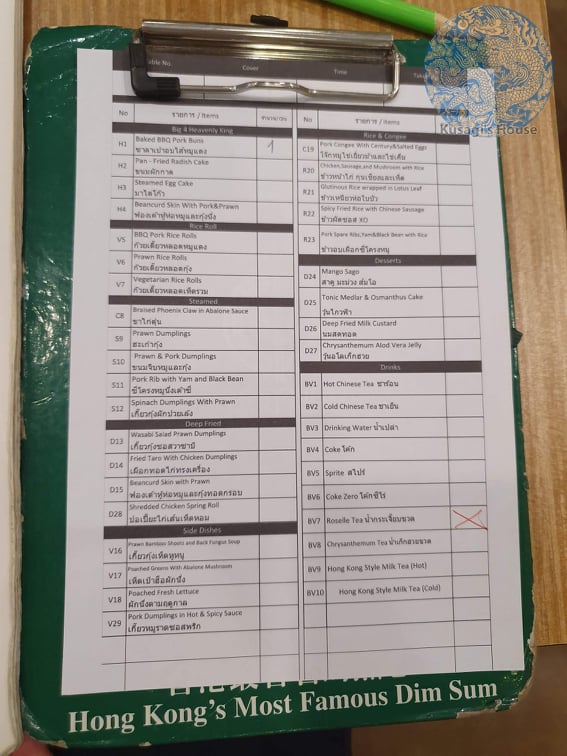
Món ăn:
Về thức uống mình từng uống thử nước lúa mạch và trà sữa ở đây. Mình thích vị trà sữa hơn, ngọt vừa, mùi trà thơm đậm, nước lúa mạch uống ngán ngán giống màu cháo, vị như sữa lợ lợ, không thích lắm.



Milk Tea – 65B
Pork Buns: (bánh bao chiên): nhà hàng này có 1 số món signature, có dấu stick trên menu, món này hình như cũng là 1 trong số đó. Bột bánh béo, giòn rụm, bên trong sốt thịt đậm đà, mặn mặn, ngọt ngọt, thơm.

Pork Buns – 120B 
Sumai & Prawn Dumpling (Xíu mại tôm thịt và há cảo tôm): xíu mại tôm thịt nhìn hấp dẫn, ướp vừa miệng rồi, có thể chấm thêm 1 tí. Há cảo lớp bột mỏng, dẻo, tôm tươi, ăn như trôi tuột vô miệng.

Sumai – 120B 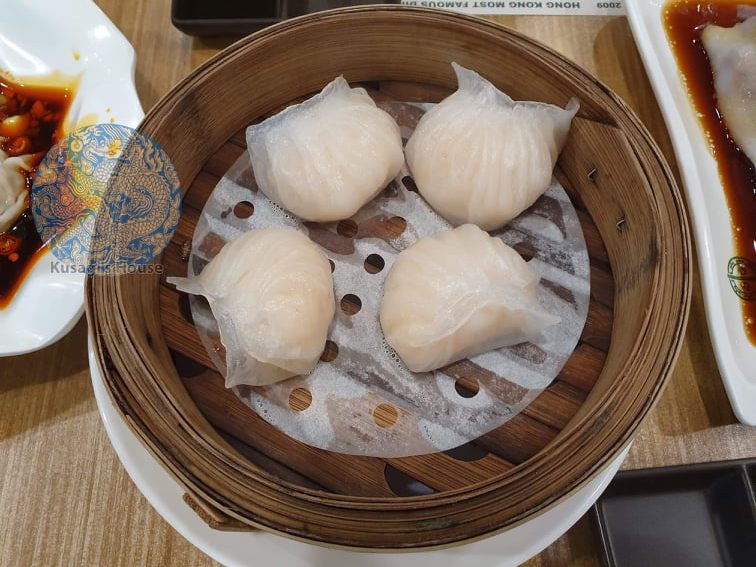
Prawn Dumpling – 130B
- Beancurd Skin with Pork & Prawn (Tàu hủ ky cuộn tôm thịt): mình thích tàu hủ ky nên gọi món này, cũng vẫn là tôm thịt lần này được cuộn trong tàu hũ ky chiên. Có chút giòn, chút béo, tôm tươi, dai, vị đậm.
- BBQ Pork Rice Rolls (Bánh ướt cuốn thịt heo): lúc trước có phiên bản cuốn gan, mình thích ăn hơn, giờ quán bỏ món này rồi. Công nhận lớp bột tráng ở đây mướt, mỏng vừa phải nên ăn ngon. Sau khi bưng ra nhân viên đổ nước sốt lên nên còn nóng hổi, sốt có pha chút vị giấm chua chua.

Beancurd Skin with Pork & Prawn – 120B 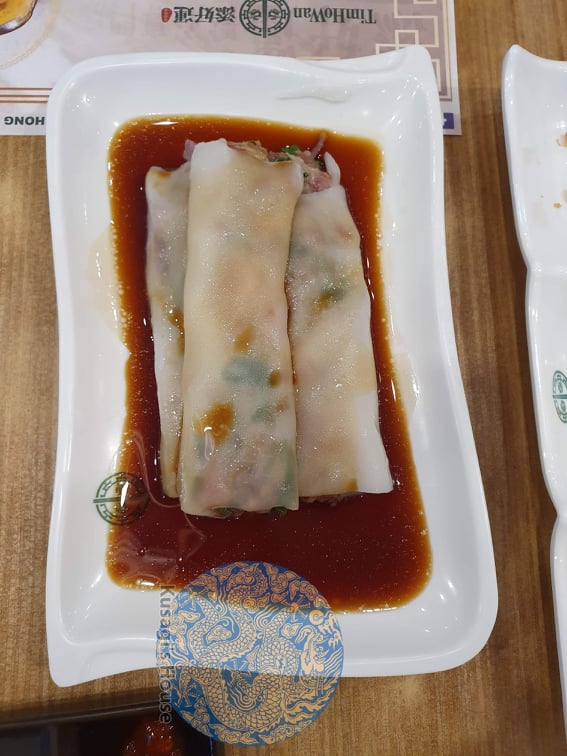
BBQ Pork Rice Rolls – 130B
Pork Dumpling in Hot & Spicy Sauce (Hoành thánh ăn kèm sốt Tứ Xuyên): món trên ăn há cảo tôm hấp rồi nên món này mình chọn hoành thánh thịt heo. Món này ăn kèm sốt chua cay Tứ Xuyên, khá thấm, sốt Tứ Xuyên ở đây ăn được, chủ yếu mình muốn ăn thử món này ở đây.
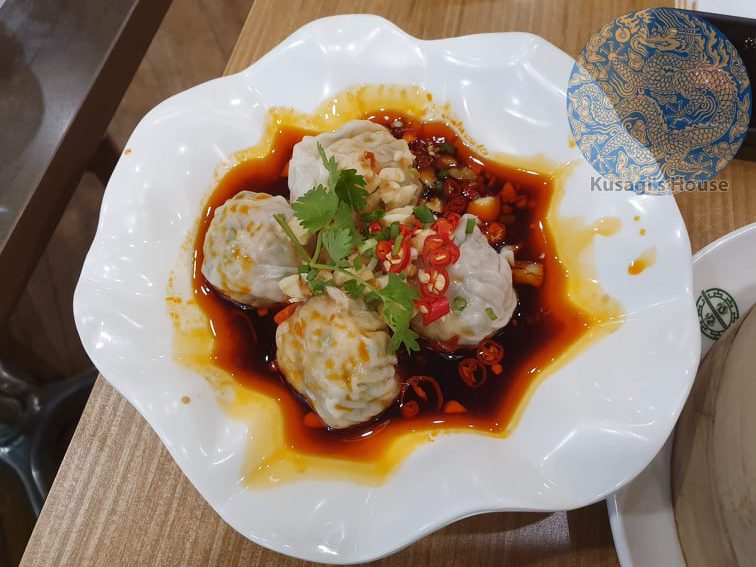
Mango Sago (chè xoài với bưởi): chè được bỏ trong tủ lạnh cho mát rồi dọn ra, không kèm đá. Ăn mát, vị ngọt ngọt, có chút xác bưởi đắng đắng, màu tươi, đẹp, ngon.

Giá cả: nếu so với những quán Dimsum ngon ở VN thì giá này quá hợp lý, thậm chí còn rẻ hơn. Ăn no căng, chất lượng, ăn ở đây rồi về VN khó tìm được chỗ ăn dimsum ngon bằng hoặc hơn. Thiệt hại: ~979.05Bath/ 2 người, khoảng 730k VND. Giá trên hình/menu chưa bao gồm 7% VAT và 10% phí phục vụ. Sử dụng thẻ Citibank thì được giảm 10% khi thanh toán.
Cảm ơn các bạn đã đọc bài viết. Hẹn gặp các bạn ở bài review tiếp theo.
Usagi


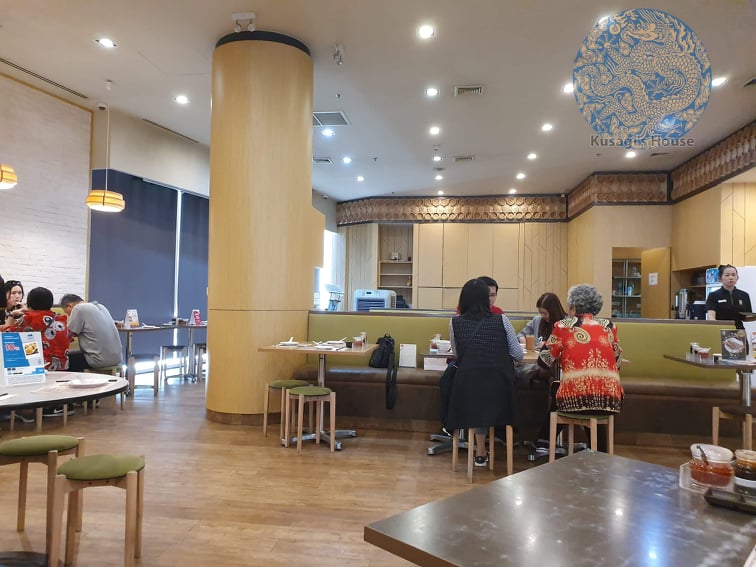
Why there’s a huge collection of vintage cars stored in the middle of the desert
base bridge
Back at the turn of the 21st century, Qatar was a country with few cultural attractions to keep visitors and residents entertained. Yet the Sheikh Faisal Bin Qassim Al Thani Museum — known as the FBQ Museum — was a place that most people visited as an alternative to the then-still rather ramshackle National Museum of Qatar.
You had to make an appointment, and drive out into the desert, getting lost a few times along the way, but then you were welcomed to the lush Al Samriya Farm with a cup of tea and some cake. The highlight was being allowed into a space crammed full with shelves and vitrines holding all sorts of eclectic artifacts from swords to coins — with the odd car and carriage standing in the grounds.
It wasn’t necessarily the kind of museum you’d find elsewhere in the world, but it was definitely a sight that needed seeing.
Today, it has grown and now claims to be one of the world’s largest private museums. It holds over 30,000 items, including a fleet of traditional dhow sailboats, and countless carpets. There’s also an entire house that once stood in Damascus, Syria.
There are archaeological finds dating to the Jurassic age, ancient copies of the Quran, a section that details the importance of pearling within Qatar’s history, and jewelry dating to the 17th century.
There are also items from 2022’s FIFA World Cup in Qatar including replica trophies, balls used in the games, entry passes, football jerseys and even shelves full of slightly creepy dolls and children’s plush animals.
Some of the more disturbing exhibits include various items of Third Reich paraphernalia in the wartime room, and, strangely enough, several showcases of birds’ legs with marking rings on them. Basically, whatever you can think of, you have a very good chance of finding it here.
Rumor even has it that behind a locked door is a room filled with the late Princess Diana’s dresses and other memorabilia, accessible only to a select few visitors. Another door hides a room, no longer open to the public, filled with collectibles of the late Saddam Hussein.
New design revealed for Airbus hydrogen plane
beefy fi
In travel news this week: Bhutan’s spectacular new airport, the world’s first 3D-printed train station has been built in Japan, plus new designs for Airbus’ zero-emission aircraft and France’s next-generation high-speed trains.
Grand designs
European aerospace giant Airbus has revealed a new design for its upcoming fully electric, hydrogen-powered ZEROe aircraft. powered by hydrogen fuel cells.
The single-aisle plane now has four engines, rather than six, each powered by their own fuel cell stack.
The reworked design comes after the news that the ZEROe will be in our skies later than Airbus hoped.
The plan was to launch a zero-emission aircraft by 2035, but now the next-generation single-aisle aircraft is slated to enter service in the second half of the 2030s.
Over in Asia, the Himalayan country of Bhutan is building a gloriously Zen-like new airport befitting a nation with its very own happiness index.
Gelephu International is designed to serve a brand new “mindfulness city,” planned for southern Bhutan, near its border with India.
In rail travel, Japan has just built the world’s first 3D-printed train station, which took just two and a half hours to construct, according to The Japan Times. That’s even shorter than the whizzy six hours it was projected to take.
France’s high-speed TGV rail service has revealed its next generation of trains, which will be capable of reaching speeds of up to 320 kilometers an hour (nearly 200 mph).
The stylish interiors have been causing a stir online, as has the double-decker dining car.
Finally, work is underway in London on turning a mile-long series of secret World War II tunnels under a tube station into a major new tourist attraction. CNN took a look inside.
Some scientists believe that fatty acids such as decanoic acid and dodecanoic acid formed the membranes of the first simple cell-like structures on Earth, Pearce said.
connext network
“(This is) the closest we’ve come to detecting a major biomolecule-related signal — something potentially tied to membrane structure, which is a key feature of life,” Pearce said via email. “Organics on their own are intriguing, but not evidence of life. In contrast, biomolecules like membranes, amino acids, nucleotides, and sugars are central components of biology as we know it, and finding any of them would be groundbreaking (we haven’t yet).”
Returning samples from Mars
The European Space Agency plans to launch its ExoMars Rosalind Franklin rover to the red planet in 2028, and the robotic explorer will carry a complementary instrument to SAM. The rover LS6 will have the capability to drill up to 6.5 feet (2 meters) beneath the Martian surface — and perhaps find larger and better-preserved organic molecules.
While Curiosity’s samples can’t be studied on Earth, the Perseverance rover has actively been collecting samples from Jezero Crater, the site of an ancient lake and river delta, all with the intention of returning them to Earth in the 2030s via a complicated symphony of missions called Mars Sample Return.
Both rovers have detected a variety of organic carbon molecules in different regions on Mars, suggesting that organic carbon is common on the red planet, Williams said.
While Curiosity and Perseverance have proven they can detect organic matter, their instruments can’t definitively determine all the answers about their origins, said Dr. Ashley Murphy, postdoctoral research scientist at the Planetary Science Institute. Murphy, who along with Williams previously studied organics identified by Perseverance, was not involved in the new research.
“To appropriately probe the biosignature question, these samples require high-resolution and high-sensitivity analyses in terrestrial labs, which can be facilitated by the return of these samples to Earth,” Murphy said.
Автор старается быть балансированным, предоставляя достаточно контекста и фактов для полного понимания читателями.
Tesla is bringing its electric cars to oil-rich Saudi Arabia amid falling global sales
aperture finance
Tesla will start selling its electric vehicles in Saudi Arabia, entering the Gulf region’s largest economy as the company’s global sales are sliding and CEO Elon Musk courts controversy with his role in the US government.
The carmaker announced Wednesday that it would host a launch event in the kingdom on April 10, where it will showcase its EVs. Attendees will also have the chance to “experience the future of autonomous driving with Cybercab and meet Optimus, our humanoid robot, as we showcase what’s next in AI and robotics,” Tesla (TSLA) said.
Tesla may struggle to gain market share in oil-rich Saudi Arabia as EVs make up a little over 1% of all car sales in the country, according to a report by consultancy PwC published in September.
Tesla’s entry into the new market comes as the company fights battles on several fronts.
Last year, it recorded the first annual decline in sales in its history as a public company, posting a drop of 1%.
The company is facing intensifying competition in China, the world’s largest auto market. On Tuesday, BYD, a Chinese maker of electric and hybrid cars, reported $107 billion in annual sales for 2024, beating the near-$98 billion notched by Tesla.
And last week, BYD unveiled an ultra-fast charging system, which it said was capable of adding 250 miles (402 km) of range in just five minutes, easily outdoing Tesla’s charging technology. Tesla’s Superchargers take 15 minutes to charge an EV, providing a range of 200 miles.
Tesla has also suffered slumping sales in Europe. In February, the carmaker sold around 40% fewer vehicles on the continent compared with the same month in 2024, according to the European Automobile Manufacturers’ Association.
Remote and rugged
eigenlayer
A more organic way to see this coast is by the multi-day coastal ferry, the long-running Sarfaq Ittuk, of the Arctic Umiaq Line. It’s less corporate than the modern cruise ships and travelers get to meet Inuit commuters. Greenland is pricey. Lettuce in a local community store might cost $10, but this coastal voyage won’t break the bank.
The hot ticket currently for exploring Greenland’s wilder side is to head to the east coast facing Europe. It’s raw and sees far fewer tourists, with a harshly dramatic coastline of fjords where icebergs drift south. There are no roads and the scattered population of just over 3,500 people inhabit a coastline roughly the distance from New York to Denver.
A growing number of small expedition vessels probe this remote coast for its frosted scenery and wildlife. Increasingly popular is the world’s largest fjord system of Scoresby Sound with its sharp-fanged mountains and hanging valleys choked by glaciers. Sailing north is the prosaically named North East Greenland National Park, fabulous for spotting wildlife on the tundra.
Travelers come to see polar bears which, during the northern hemisphere’s summer, move closer to land as the sea-ice melts. There are also musk oxen, great flocks of migrating geese, Arctic foxes and walrus.
Some of these animals are fair game for the local communities. Perhaps Greenland’s most interesting cultural visit is to a village that will take longer to learn how to pronounce than actually walk around — Ittoqqortoormiit. Five hundred miles north of its neighboring settlement, the 345 locals are frozen in for nine months of the year. Ships sail in to meet them during the brief summer melt between June and August.
Locked in by ice, they’ve retained traditional habits.
“My parents hunt nearly all their food,” said Mette Barselajsen, who owns Ittoqqortoormiit’s only guesthouse. “They prefer the old ways, burying it in the ground to ferment and preserve it. Just one muskox can bring 440 pounds of meat.”
Curiosity has maintained pristine pieces of the Cumberland sample in a “doggy bag” so that the team could have the rover revisit it later, even miles away from the site where it was collected. The team developed and tested innovative methods in its lab on Earth before sending messages to the rover to try experiments on the sample.
changelly exchange
In a quest to see whether amino acids, the building blocks of proteins, existed in the sample, the team instructed the rover to heat up the sample twice within SAM’s oven. When it measured the mass of the molecules released during heating, there weren’t any amino acids, but they found something entirely unexpected.
An intriguing detection
The team was surprised to detect small amounts of decane, undecane and dodecane, so it had to conduct a reverse experiment on Earth to determine whether these organic compounds were the remnants of the fatty acids undecanoic acid, dodecanoic acid and tridecanoic acid, respectively.
The scientists mixed undecanoic acid into a clay similar to what exists on Mars and heated it up in a way that mimicked conditions within SAM’s oven. The undecanoic acid released decane, just like what Curiosity detected.
Each fatty acid remnant detected by Curiosity was made with a long chain of 11 to 13 carbon atoms. Previous molecules detected on Mars were smaller, meaning their atomic weight was less than the molecules found in the new study, and simpler.
“It’s notable that non-biological processes typically make shorter fatty acids, with less than 12 carbons,” said study coauthor Dr. Amy Williams, associate professor of geology at the University of Florida and assistant director of the Astraeus Space Institute, in an email. “Larger and more complex molecules are likely what are required for an origin of life, if it ever occurred on Mars.”
Water and life
stargate finance
Lightning is a dramatic display of electrical power, but it is also sporadic and unpredictable. Even on a volatile Earth billions of years ago, lightning may have been too infrequent to produce amino acids in quantities sufficient for life — a fact that has cast doubt on such theories in the past, Zare said.
Water spray, however, would have been more common than lightning. A more likely scenario is that mist-generated microlightning constantly zapped amino acids into existence from pools and puddles, where the molecules could accumulate and form more complex molecules, eventually leading to the evolution of life.
“Microdischarges between obviously charged water microdroplets make all the organic molecules observed previously in the Miller-Urey experiment,” Zare said. “We propose that this is a new mechanism for the prebiotic synthesis of molecules that constitute the building blocks of life.”
However, even with the new findings about microlightning, questions remain about life’s origins, he added. While some scientists support the notion of electrically charged beginnings for life’s earliest building blocks, an alternative abiogenesis hypothesis proposes that Earth’s first amino acids were cooked up around hydrothermal vents on the seafloor, produced by a combination of seawater, hydrogen-rich fluids and extreme pressure.
Researchers identified salt minerals in the Bennu samples that were deposited as a result of brine evaporation from the asteroid’s parent body. In particular, they found a number of sodium salts, such as the needles of hydrated sodium carbonate highlighted in purple in this false-colored image – salts that could easily have been compromised if the samples had been exposed to water in Earth’s atmosphere.
Related article
Yet another hypothesis suggests that organic molecules didn’t originate on Earth at all. Rather, they formed in space and were carried here by comets or fragments of asteroids, a process known as panspermia.
“We still don’t know the answer to this question,” Zare said. “But I think we’re closer to understanding something more about what could have happened.”
Though the details of life’s origins on Earth may never be fully explained, “this study provides another avenue for the formation of molecules crucial to the origin of life,” Williams said. “Water is a ubiquitous aspect of our world, giving rise to the moniker ‘Blue Marble’ to describe the Earth from space. Perhaps the falling of water, the most crucial element that sustains us, also played a greater role in the origin of life on Earth than we previously recognized.”
Iceberg flotillas
debridge
Located on the west coast, Ilulissat is a pretty halibut- and prawn-fishing port on a dark rock bay where visitors can sit in pubs sipping craft beers chill-filtered by 100,000-year-old glacial ice.
It’s a place to be awed by the UNESCO World Heritage Icefjord where Manhattan skyscraper-sized icebergs disgorge from Greenland’s icecap to float like ghostly ships in the surrounding Disko Bay.
Small boats take visitors out to sail closely among the bay’s magnificent iceberg flotilla. But not too close.
“I was on my boat once and saw one of these icebergs split in two. The pieces fell backwards into the sea and created a giant wave,” said David Karlsen, skipper of the pleasure-boat, Katak. “…I didn’t hang around.”
Disko Bay’s other giants are whales. From June to September breaching humpback whales join the likes of fin and minke whales feasting on plankton. Whale-watching is excellent all around Greenland’s craggy coastline.
Whales are eaten here. Visitors shouldn’t be surprised to encounter the traditional Greenlandic delicacy of mattak — whale-skin and blubber that when tasted is akin to chewing on rubber. Inuit communities have quotas to not only hunt the likes of narwhals but also polar bears, musk-ox and caribou — which can also appear on menus.
‘For the public to enjoy’
keplr wallet
The museum’s history starts in 1998, when Sheikh Faisal Bin Qassim Al Thani opened a building to the public on his farm some 20 kilometers (12 miles) north of Qatari capital Doha.
A distant relative of Qatar’s ruling family, founder and chairman of Al Faisal Holdings (one of Qatar’s biggest conglomerates), and a billionaire whose business acumen had him recognized as one of the most influential Arab businessmen in the world, Sheikh Faisal had already amassed a substantial private collection of historically important regional artifacts, plus a few quirky pieces of interest, allowing visitors an intimate look into Qatari life and history.
In an interview with Qatari channel Alrayyan TV in 2018, Sheikh Faisal said that the museum started as a hobby.
“I used to collect items whenever I got the chance,” he said. “As my business grew, so did my collections, and soon I was able to collect more and more items until I decided to put them in the museum for the public to enjoy.”
His private cabinet of curiosities has since evolved into a 130-acre complex. Through the fort-like entrance gate lies an oryx reserve, an impressive riding school and stables, a duck pond and a mosque built with a quirky leaning minaret. There’s now even a five-star Marriott hotel, two cafes and the Zoufa restaurant serving modern Lebanese cuisine.
Of course, there’s also the super-sized museum, with a recently-opened car collection housing everything from vintage Rolls-Royces to wartime Jeeps and colorful Buicks. Outside you’ll find peacocks roaming the grounds, and signs warning drivers to be aware of horses and ostriches.
Visitors to the FBQ museum are free to explore the grounds and can even enter the stables to pat the horses.
A long time in the making
Curiosity landed in Gale Crater on August 6, 2012. More than 12 years later, the rover has driven over 21 miles (34 kilometers) to ascend Mount Sharp, which is within the crater. The feature’s many layers preserve millions of years of geological history on Mars, showing how it shifted from a wet to a dry environment.
cbridge
Perhaps one of the most valuable samples Curiosity has gathered on its mission to understand whether Mars was ever habitable was collected in May 2013.
The rover drilled the Cumberland sample from an area within a crater called Yellowknife Bay, which resembled an ancient lake bed. The rocks from Yellowknife Bay so intrigued Curiosity’s science team that it had the rover drive in the opposite direction to collect samples from the area before heading to Mount Sharp.
Since collecting the Cumberland sample, Curiosity has used SAM to study it in a variety of ways, revealing that Yellowknife Bay was once the site of an ancient lake where clay minerals formed in water. The mudstone created an environment that could concentrate and preserve organic molecules and trapped them inside the fine grains of the sedimentary rock.
Freissinet helped lead a research team in 2015 that was able to identify organic molecules within the Cumberland sample.
The instrument detected an abundance of sulfur, which can be used to preserve organic molecules; nitrates, which are essential for plant and animal health on Earth; and methane composed of a type of carbon associated with biological processes on Earth.
“There is evidence that liquid water existed in Gale Crater for millions of years and probably much longer, which means there was enough time for life-forming chemistry to happen in these crater-lake environments on Mars,” said study coauthor Daniel Glavin, senior scientist for sample return at NASA’s Goddard Space Flight Center in Greenbelt, Maryland, in a statement.
Curiosity rover makes ‘arguably the most exciting organic detection to date on Mars’
bungee exchange
The NASA Curiosity rover has detected the largest organic molecules found to date on Mars, opening a window into the red planet’s past. The newly detected compounds suggest complex organic chemistry may have occurred in the planet’s past — the kind necessary for the origin of life, according to new research.
The organic compounds, which include decane, undecane and dodecane, came to light after the rover analyzed a pulverized 3.7 billion-year-old rock sample using its onboard mini lab called SAM, short for Sample Analysis at Mars.
Scientists believe the long chains of molecules could be fragments of fatty acids, which are organic molecules that are chemical building blocks of life on Earth and help form cell membranes. But such compounds can also be formed without the presence of life, created when water interacts with minerals in hydrothermal vents.
The molecules cannot currently be confirmed as evidence of past life on the red planet, but they add to the growing list of compounds that robotic explorers have discovered on Mars in recent years. A study detailing the findings was published Monday in the journal Proceedings of the National Academy of Sciences.
The detection of the fragile molecules also encourages astrobiologists that if any biosignatures, or past signs of life, ever existed on Mars, they are likely still detectable despite the harsh solar radiation that has bombarded the planet for tens of millions of years.
“Ancient life, if it happened on Mars, it would have released some complex and fragile molecules,” said lead study author Dr. Caroline Freissinet, research scientist at the French National Centre for Scientific Research in the Laboratory for Atmospheres, Observations, and Space in Guyancourt, France. “And because now we know that Mars can preserve these complex and fragile molecules, it means that we could detect ancient life on Mars.”
Everyone is talking about Greenland. Here’s what it’s like to visit
cow fi
A few months ago, Greenland was quietly getting on with winter, as the territory slid deeper into the darkness that envelops the world’s northerly reaches at this time of year.
But President Donald Trump’s musings about America taking over this island of 56,000 largely Inuit people, halfway between New York and Moscow, has seen Greenland shaken from its frozen Arctic anonymity.
Denmark, for whom Greenland is an autonomous crown dependency, has protested it’s not for sale. Officials in Greenland, meanwhile, have sought to assert the territory’s right to independence.
The conversation continues to intensify. A contentious March 28 visit to a US military installation by Usha Vance, the second lady, accompanied by her husband, Vice President JD Vance, was the latest in a series of events to focus attention on Trump’s ambitions for Greenland.
The visit was originally planned as a cultural exchange, but was shortened following complaints from Greenland Prime Minister Mute B. Egede.
Had the Vances prolonged their scheduled brief visit, they would’ve discovered a ruggedly pristine wildernesses steeped in rich Indigenous culture.
An inhospitable icecap several miles deep covers 80% of Greenland, forcing the Inuit to dwell along the shorelines in brightly painted communities. Here, they spend brutally cold winters hunting seals on ice under the northern lights in near perpetual darkness. Although these days, they can also rely on community stores.
The problem for travelers over the years has been getting to Greenland via time-consuming indirect flights. That’s changing. Late in 2024, the capital Nuuk opened a long-delayed international airport. From June 2025, United Airlines will be operating a twice-weekly direct service from Newark to Nuuk.
Two further international airports are due to open by 2026 — Qaqortoq in South Greenland and more significantly in Ilulissat, the island’s only real tourism hotspot.
While the Cumberland sample may contain longer chains of fatty acids, SAM is not designed to detect them. But SAM’s ability to spot these larger molecules suggests it could detect similar chemical signatures of past life on Mars if they’re present, Williams said.
convex finance
“Curiosity is not a life detection mission,” Freissinet said. “Curiosity is a habitability detection mission to know if all the conditions were right … for life to evolve. Having these results, it’s really at the edge of the capabilities of Curiosity, and it’s even maybe better than what we had expected from this mission.”
Before sending missions to Mars, scientists didn’t think organic molecules would be found on the red planet because of the intensity of radiation Mars has long endured, Glavin said.
Curiosity won’t return to Yellowknife Bay during its mission, but there are still pristine pieces of the Cumberland sample aboard. Next, the team wants to design a new experiment to see what it can detect. If the team can identify similar long-chain molecules, it would mark another step forward that might help researchers determine their origins, Freissinet said.
“That’s the most precious sample we have on board … waiting for us to run the perfect experiment on it,” she said. “It holds secrets, and we need to decipher the secrets.”
Briony Horgan, coinvestigator on the Perseverance rover mission and professor of planetary science at Purdue University in West Lafayette, Indiana, called the detection “a big win for the whole team.” Horgan was not involved the study.
“This detection really confirms our hopes that sediments laid down in ancient watery environments on Mars could preserve a treasure trove of organic molecules that can tell us about everything from prebiotic processes and pathways for the origin of life, to potential biosignatures from ancient organisms,” Horgan said.
Dr. Ben K.D. Pearce, assistant professor in Purdue’s department of Earth, atmospheric, and planetary sciences and leader of the Laboratory for Origins and Astrobiology Research, called the findings “arguably the most exciting organic detection to date on Mars.” Pearce did not participate in the research.
Arctic auroras
ethena
For getting around during winter, the Inuit here nowadays prefer snowmobiles, although they still keep their sled dogs. During winter they’ll offer intrepid visitors, wrapped up warm against the deep-freeze temperatures, dog-sledding jaunts. These can last either an hour or be part of expeditions over several days, sometimes with the added experience of learning how to build an igloo. Sisimiut on the west coast and Tasilaq in the southeast are active winter centers for dog sledding.
Winter’s most stellar attraction, though, is northern lights watching. With little urban light pollution, Greenland is a dark canvas for spectacular displays, and aurora borealis-watching vacations are becoming more popular.
Staying outdoors, Greenland is developing a reputation among adventure enthusiasts: from long-distance skiing expeditions and heliskiing on the icecap to hiking the 100-mile-long Arctic Circle Trail from Kangerslussuaq, where firearms need to be carried for warning shots in case of polar bear encounters.
Life is definitely changing here. The climate crisis is eating away at its icecap and Greenland may well end up as a pawn in a game of geopolitical chess. But for now, the bright glare of international attention should shine a favorable light on one of the wildest travel destinations on Earth.
Travel writer Mark Stratton is an Arctic specialist who has traveled to Greenland six times and counting. He’s marveled at the aurora borealis, sailed to Disko Island, dog-sledded with the Inuit, and once got stuck in an icefloe.
https://jak-obstawiac-hokej.hodowcyroz.pl/
Hello to every , as I am genuinely keen of reading this webpage’s post to be updated on a regular basis.
It includes good material.
посмотреть в этом разделе Манго Офис телефония
перенаправляется сюда Манго Офис телефония
найти это Манго Офис настройка АТС